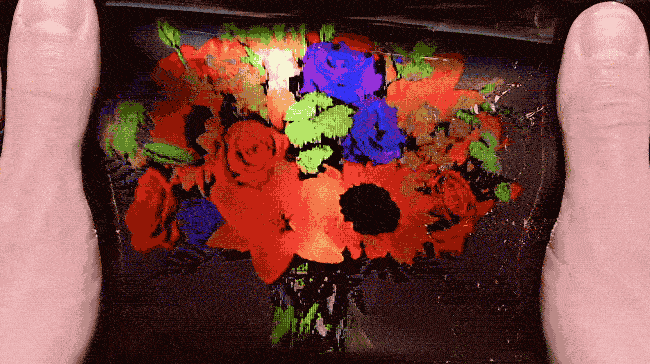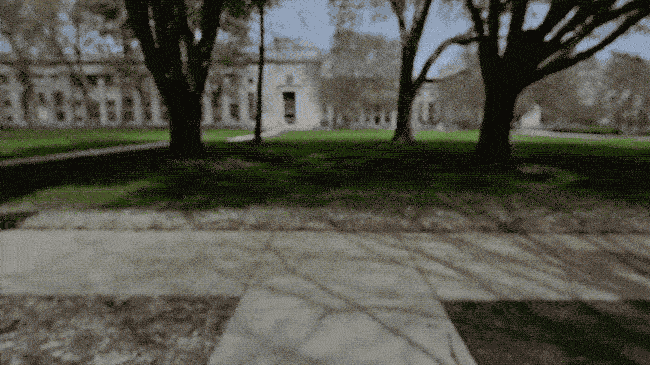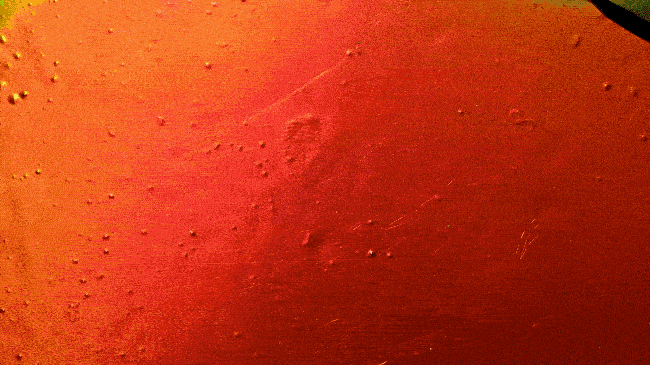Did you know that the bright iridescence in a butterfly’s wing or beetle’s shell comes not from any pigment molecules, but from the structure of the wing — a naturally occurring example of what physicists call a “photonic crystal.” Scientists can now make their own structurally colored materials in the lab, but scaling up the process to commercial applications without sacrificing optical precision will be a challenge.
Now, MIT scientists have taken a 19th-century technique of holography to develop a chameleon-like film that changes color when stretched. The method can also be easily scaled while maintaining nanoscale optical precision. They describe their work in a new paper published in the journal Nature Materials.
In nature, scales of chitin, a polysaccharide common to insects, line up like the tiles of a roof. Essentially, they form diffraction gratings, except that photonic crystals produce only a specific color or wavelength of light, while diffraction gratings produce the entire spectrum, just like a prism. Photonic crystals, also known as photonic bandgap materials, are “tunable,” meaning they can precisely block certain wavelengths of light while letting other wavelengths through. By changing the structure by changing the size of the “tiles (scales)”, the crystals become sensitive to different wavelengths.

Creating structural colors like those found in nature is an active area of materials research. For example, optical sensing and visual communication applications will benefit from structurally colored materials that can change hue in response to mechanical stimuli. There are several techniques for making this material, but none of them can both control the structure on the small scale needed and scale it up outside the laboratory setting.
Later, MIT graduate student Benjamin Miller, a co-author of the paper, found an exhibit on holography at the MIT Museum and realized that making holography was in some ways related to nature. Structural colors work in a similar way. He delved into the history of holography, learning about color photography, invented by physicist Gabriel Lippmann at the end of the 19th century.
Above: Gabriel Lippmann works in physics at the Sorbonne laboratory.
In 1886, physicist Gabriel Lippmann became interested in developing a way to fix the colors of the solar spectrum on a photographic film, “so that the image would remain fixed and not deteriorate in sunlight.” He achieved this in 1891, creating a colourful image of a stained glass window, a bowl of oranges and a coloured parrot, as well as landscapes and portraits – including a self-portrait.
Lippmann’s color photography process involves projecting an optical image onto a photosensitive plate as usual. The projection is done through a glass plate, the other side of which is coated with a clear emulsion of very fine silver halide grains. There is also a liquid mercury mirror in contact with the emulsion, so the projected light passes through the emulsion, hits the mirror, and is reflected back into the emulsion.
The resulting optical interference pattern exposes the emulsion at different depths, essentially encoding the emulsion in the interference pattern. After a few minutes of exposure, the panels were removed from the liquid mercury and processed.

For easy viewing, the finished board is turned upside down and a prism is attached to the surface, usually using Canada balsam adhesive. Then, illuminate the board at a vertical angle from the front with white light. At any point on the plate, as long as the wavelength of the light that produced the sheet matches the wavelength of the incident light, the light will be reflected toward the viewer. Other wavelengths are absorbed or scattered by the silver particles, or pass directly through the emulsion and are absorbed by the black anti-reflective coating on the back of the slab.
However, Lippmann’s method never caught on commercially, mainly because it required long exposure times and there was no way to produce color prints. Fortunately, holographic materials (composed of photosensitive molecules that cross-link under light to form colored mirrors) have come a long way since Lippmann’s time. Mathias Kolle, co-author of the project, said: “The chemistry of these modern holographic materials is so sensitive that with just a projector, this technology can be accomplished in a short amount of time.”
The team placed a commercial elastic photopolymer on an aluminum plate and projected various images onto the sample using a standard off-the-shelf projector. It takes minutes to create large, vividly detailed color images. Then, they peeled off the holographic film and glued it to a black elastic silicone substrate.
When they stretched the film, the color changed as the stretching and thinning of the film caused the nanoscale structure to reconfigure, reflecting slightly different wavelengths. The film remains red in the thinnest areas and turns blue in the thicker areas. Also, pressing things like strawberries, coins or fingers into the red film will leave a fine green imprint.
Benjamin Miller said: “Now that we have cleared this barrier to expansion, we can explore questions like: Can we use this material to make robotic skin with a human-like touch? Could we use this material for virtual augmented reality or medical Training, etc. to create touch-sensing devices? What we’re seeing now is a big area.”

In fact, these color-changing films are ideal for making bandages that change color based on pressure to let medical staff know if they’re wrapping too tightly — a tool when treating conditions such as venous ulcers, pressure ulcers, lymphedema and scarring Key factor. Kids will love wearing color-changing bandages, which is a boon for pediatricians, too. This material can be made into large-area flakes and has broad application prospects in clothing and sportswear. Matthias Kohler said: “Lippmann’s material didn’t even allow him to produce a Speedo. Now, we can make a full bodysuit.”
The MIT team also found that by angling the film during photography, hidden images could be projected, providing a way to encode secret messages. Using red light during exposure creates a film that reflects infrared, which is invisible to humans. Stretching the resulting film turns the image red, revealing the hidden image.



GIPHY App Key not set. Please check settings